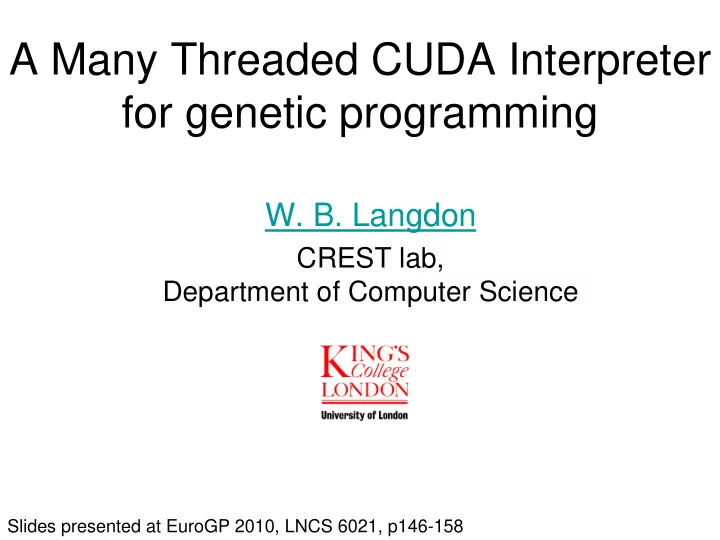

A Many Threaded CUDA Interpreter for genetic programming W. B. Langdon CREST lab, Department of Computer Science Slides presented at EuroGP 2010, LNCS 6021, p146-158
Introduction • Running tree GP on graphics hardware • How • 8692 times faster than PC without GPU • Solved 20 input Boolean multiplexor problem • Solved 37 input Boolean multiplexor problem (all 137 10 9 tests) W. B. Langdon, King's London 2
Threat: No More Moore’s Law • CPUs no longer double in speed • BUT number of transistors is still doubling – More complicated CPU – Parallel • Today a single graphics card can contain hundreds of fully functioning CPUs running in parallel W. B. Langdon, King's London 3
Benefit: Moore’s Law applies to number of transistors 2 240 Stream Processors Clock 1.24 GHz ¾ Tflop (nbody estimate) 1992 MByte Available 1.5GHz 4 tesla up to 16GBytes Fermi 64 bit (March 26) 512 processors 3 billion transistors 1.35 Tflops (manufacture) nVidia GeForce 295 GTX 4⅜ inches 10½
ATI 5870 GPU v PC 1600 cpus Fermi
Speed up • Speed comes from combining and improving four GP techniques: – Graphics hardware – Sub machine code GP (use all 32 bits) – Random sampling of fitness cases – Reverse Polish Notation CUDA interpreter Graphics hardware 480 Sub machine code GP 32 Sampling fitness cases 512 (20 mux) 16,777,216 (37 mux) RPN CUDA interpreter 1
Sub Machine Code GP • Graphics cards supports many data types – RapidMind 2 only used float • Pack 32 Boolean bits into one integer – AND int does 32 Boolean logic in one go • Each thread does 32 fitness cases – All tests for D 0 D 1 D 2 D 3 D 4 in one go • Correct bit mask = ~(answer XOR target) – Fitness = count correct bits – Seibert’s fast bit count (3 lines v loop 32 ) 7
Sampling Fitness Cases 1 • Too many training cases to use all. – So train on randomly selected sample • When a GP individual passes all 8192 tests in the random sample, then check all 137 10 9 tests. • Use whole GPU to test one program – Can stop first time any test fails – If fail abort other tests running in parallel
Sampling Fitness Cases 2 • Using submachine code GP so can test all 32 lower 5 bits patterns. Sample top 32bits • For each random pattern invert top 32bits to also test its complement. • Sample needs 8192/32/2=128 pseudo random numbers • Reduce noise by using same random sample for all 4 members of tournament • Each generation and each tournament has different sample
Reverse Polish Tree Interpreter (Mul (Sub A 10) B ) ≡ A 10 - B Variable (terminal): push onto stack Function pop arguments, do operation, push result 1 stack per program. All stacks in shared memory. PC moves linearly from start→end expression
Representing the Population • Same structure on host as GPU. – Avoid explicit format conversion when population is loaded onto GPU. • Genetic operations act on Reverse Polish: – random tree generation (eg ramped-half-and-half) – subtree crossover – 2 types of mutation • Requires only one byte per leaf or function. – So large populations (millions of individuals) are possible. • Like GPquick (but GPquick uses linearised prefix ) • nVidia CUDA kernel replaces RapidMind 11
CUDA Interpreter: Summary • Put stack in fast shared memory • Randomised testing • Choice between sequential and parallel • Use 1↔256 threads for one test – reduce by parallel sum into one fitness value. – Siebert’s bit count (replaces 32 loops) • 1 Program in fast read-only global memory • Interprets 261 10 9 GP primitives per sec. • (670 billion per second sustained peak)
Experiments • 20 multiplexor solved – Full test 2 20 = 1,048,576 – sample size = 2048 • 37 multiplexor solved – Full test 2 37 =137 billion test cases – sample size = 8192 W. B. Langdon, King's London 13
Boolean Multiplexor d = 2 a n = a + d Num test cases = 2 n 20-mux 1 million test cases 37-mux 137 10 9 tests
20-Mux 37-Mux • Function set: AND OR NAND NOR • Terminal set: D 0 ..D 37 (D 0 -D 5 packed into int) • Fitness: tests past • Population: ¼ million binary trees • Parameters: – Ramped ½-½, tournament size=4, – 50% crossover, 50% mix of mutation, – max depth 15, max size 1023. • Up to 5000 generations 15
Evolution of 20-Mux and 37-Mux W. B. Langdon, King's London 16
Performance v Test v Threads W. B. Langdon, King's London 17
Performance v Program size W. B. Langdon, King's London 18
GP Performance 295 GTX • GPU 261 10 9 GP operations/second averaged across whole run. – GPU so fast fitness testing not dominating. PC host now also important (not optimised) • Sustained peak 670 10 9 GP ops/sec – When validation single best program – One program fits in “constant” memory – 37-Mux speed up 476 10 9 → 670 10 9 W. B. Langdon, King's London 19
Code via FTP cs.ucl.ac.uk/genetic/gp-code/gp32cuda.tar.gz Conclusions • GP CUDA interpreter allows choices of – which aspects of fitness are done in parallel – explicit location of key data structures to get best from GPU hardware. • Submachine code GP on graphics cards • Randomise test case selection – Evolve on tiny (less than 10 -6 th) fraction of whole. Then validates on all. • Cheap - your own “cluster” performance • FAST - 20-mux and 37-mux solved. W. B. Langdon, King's London 20
Recommend
More recommend